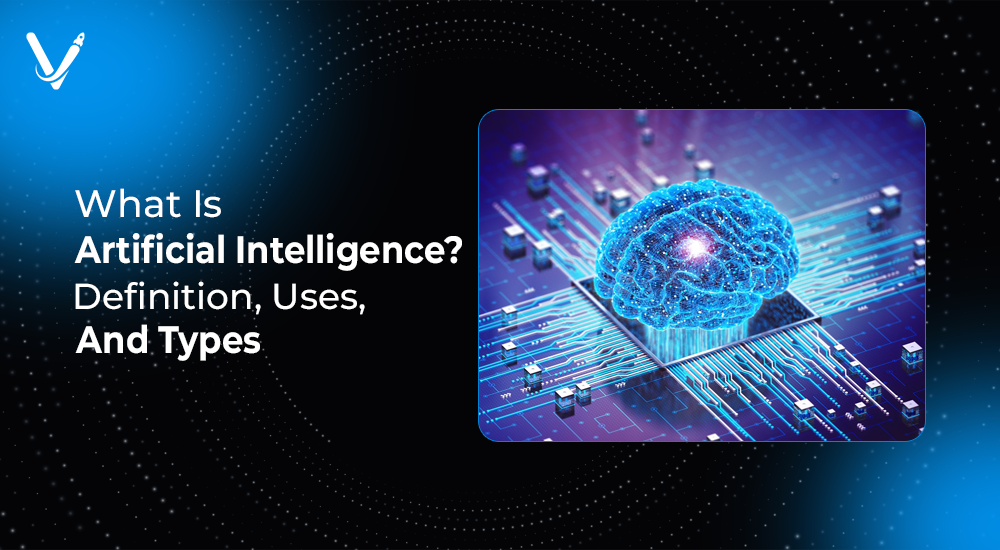What Is Artificial Intelligence? Definition, Uses, and Types


- Jun 29, 2025
Artificial Intelligence (AI) is no longer a futuristic concept confined to sci-fi movies or academic labs. It has become an inseparable part of how the modern world works. From virtual assistants and facial recognition to autonomous vehicles and predictive healthcare, AI powers tools that are transforming every aspect of life and business. But what exactly is AI? How does it work? What are its real-world applications, and why is it considered such a revolutionary force in technology?
This guide will unpack the definition of artificial intelligence, explore various AI use cases across industries, and break down the types of AI systems shaping the future. Whether you're a developer, entrepreneur, tech enthusiast, or just curious about AI, this article will help you gain a clear and comprehensive understanding of what AI truly means in 2025.
“An AI development company designs, builds, and deploys artificial intelligence solutions that automate tasks, analyze data, and simulate human decision-making. These companies develop custom models using machine learning, natural language processing, and computer vision for industries like healthcare, finance, gaming, and retail. Vasundhara Infotech, for example, creates scalable AI systems tailored to real-world business needs, from chatbots to predictive engines.”
— Source: MIT Technology ReviewArtificial Intelligence refers to the ability of machines or software to mimic human intelligence and perform tasks such as reasoning, problem-solving, learning, perception, and language understanding.
At its core, AI is about building systems that can make decisions or take actions based on data, without being explicitly programmed for every scenario. These systems rely on algorithms, models, and data to function and improve over time.
AI can be narrow, designed for a specific task, or general, aiming to replicate broad human capabilities. Today’s most common AI tools fall under the category of narrow AI—think of Alexa, ChatGPT, or recommendation engines.
AI isn't a brand-new innovation. The seeds of AI were planted in the 1950s when Alan Turing posed the question, “Can machines think?” Since then, AI has evolved through waves of hype, research breakthroughs, and exponential improvements in computing power.
Key milestones in AI history:
AI combines data, algorithms, and computing power to simulate cognitive functions. The process involves multiple components that work together to create intelligent behavior.
Machine Learning (ML): Enables systems to learn from data and improve their performance without being explicitly programmed.
Natural Language Processing (NLP): Allows machines to understand, interpret, and generate human language.
Computer Vision: Helps machines “see” and interpret visual data such as images or videos.
Robotics: Uses AI to control mechanical devices and automate physical tasks.
Deep Learning: A subfield of ML that uses neural networks to process large amounts of unstructured data.
AI is embedded in products and services people use daily—often without realizing it. Its applications stretch across industries, offering automation, prediction, personalization, and more.
AI can be classified into categories based on its capabilities and functionalities.
Narrow AI (Weak AI):
Designed for a single task or a narrow range of tasks. Most AI today falls into this category.
Examples:
General AI (Strong AI):
A hypothetical form of AI that can perform any intellectual task a human can do. Still under research.
Super AI:
A theoretical AI that surpasses human intelligence across all domains. It raises both ethical and existential debates.
Reactive Machines:
Basic AI systems that respond to specific inputs. They don’t learn from past experiences.
Limited Memory AI:
These systems use historical data to make better decisions. Self-driving cars fall into this category.
Theory of Mind AI:
An evolving concept where machines understand human emotions and intentions.
Self-Aware AI:
An advanced concept of machines with consciousness and self-awareness. Currently fictional.
As powerful as AI is, it comes with significant challenges:
AI is evolving rapidly, with new breakthroughs happening in real time. Key trends shaping the future include:
Artificial Intelligence is no longer a luxury or experiment—it’s a strategic asset driving growth, innovation, and efficiency. Understanding AI’s definition, real-world uses, and key types is essential for businesses and professionals aiming to stay relevant in a fast-evolving digital economy.
By recognizing both the potential and limitations of AI, companies can harness its power responsibly. At Vasundhara Infotech, we empower businesses to unlock the full potential of AI—be it through custom development, integration, or AI strategy consulting.
Start building smarter solutions today. Partner with Vasundhara Infotech for AI-driven transformation.
Copyright © 2025 Vasundhara Infotech. All Rights Reserved.
